 beyond Krishnanagar.jpg)
The renovated NH-12 (NH-34) beyond Krishnanagar
Imagine driving past the iconic city of Murshidabad, turning a deaf ear to the call of its glory and grandiosity, its mosques and monuments, to discover a couple of nondescript villages, replete with history and heritage, quietly fading into obscurity, on the banks of the gorgeous Ganga. Team WHEELS drove to the heritage town of Cossimbazar near Murshidabad and rediscovered the historic village of Azimganj on the other bank of the Ganges, lost in the abyss of time.
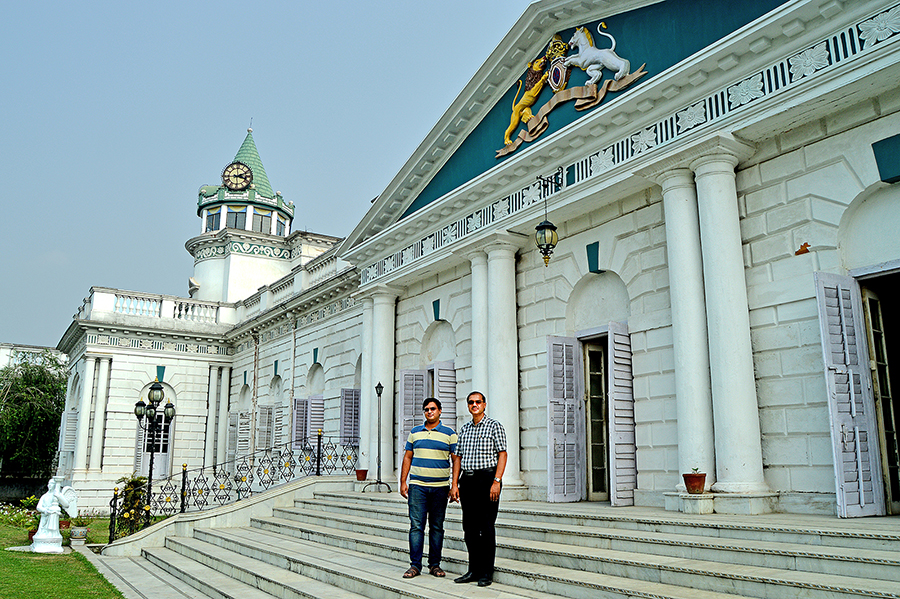
Pallab Roy and his son Saurav – scions of the Roys
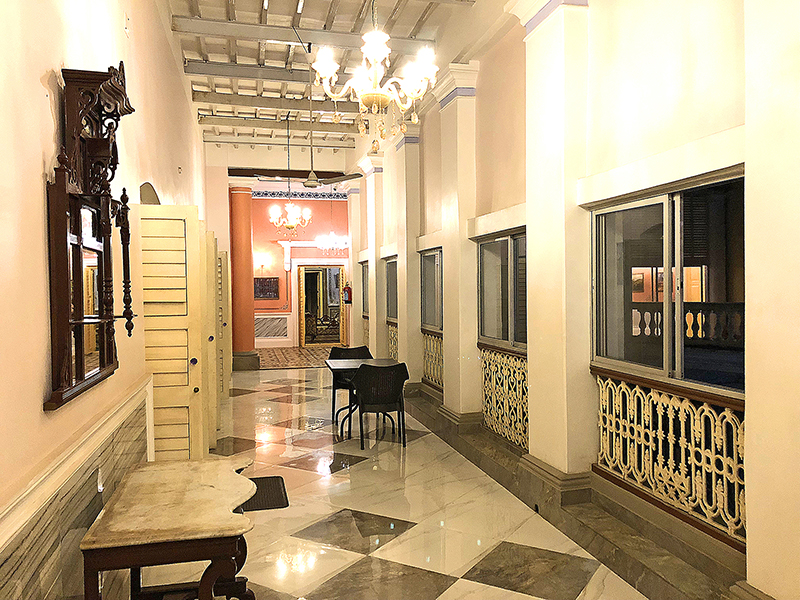
The lavish verandah – Cossimbazar Palace
Route
Begin your journey from Ultadanga intersection in Kolkata and proceed by the VIP Road. On meeting Jessore Road NH-12 (NH-34) near Dumdum Airport, turn right and proceed northward by the NH-34 towards Barasat. On reaching the Dak Bungalow Morh at Barasat take the left from the Y-fork and continue by the NH-12 (NH-34) passing through Amdanga, Barojaguli, Birohi, Chakdah, Ranaghat, Fulia to reach Krishnanagar. Take the left from the Y-fork at Krishnanagar again to follow NH-12 (NH-34) and go past Bethuadahari and Palassi to reach Baharampur in Murshidabad. From Baharampur Panchanatala Morh take left, and an immediate right into Karbala Road leaving NH-12 (NH-34) leading to Cossimbazar Rajbari.
The present road condition of NH-12 (NH-34) as of 13 May 2019, is average up to Krishnanagar - approximately 112 km, being an old highway. The road condition improves dramatically after Krishnanagar town and continues right up to Baharampur with the new 4-lane highway for 80+ km.
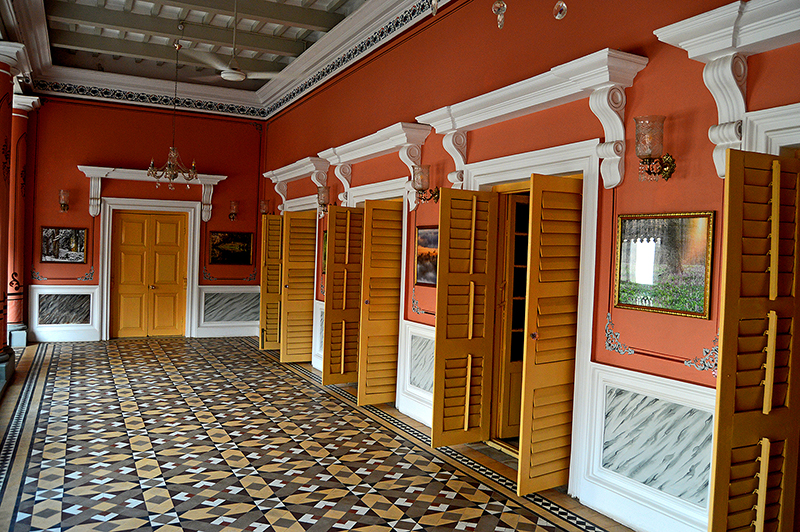
The aesthetically revamped palace corridor
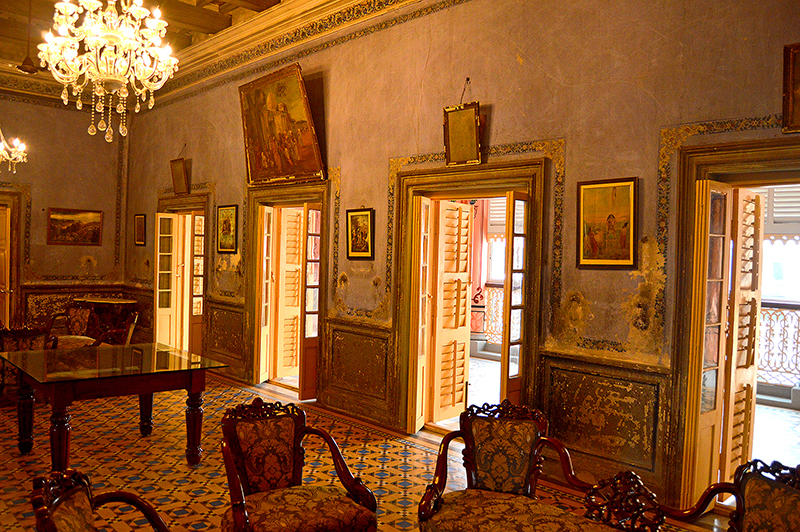
The elegant decor inside the palace
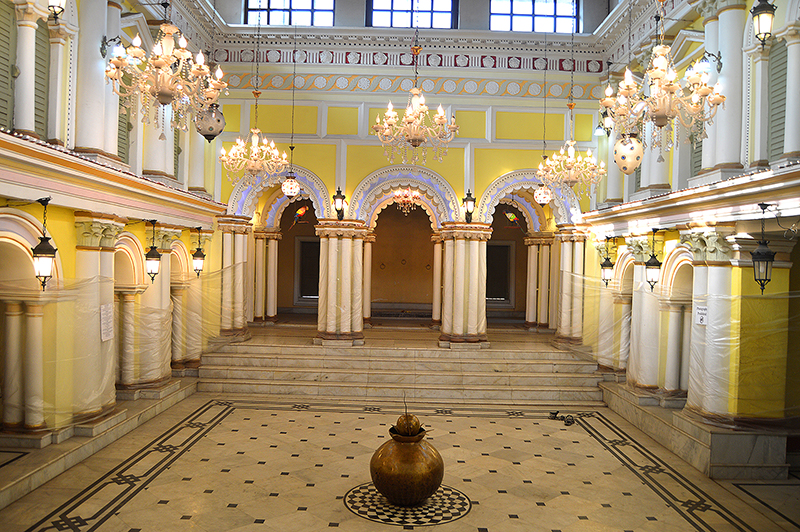
The intimidating Sabhaghar – Cossimbazar Palace
Cossimbazar
Kashimbazar or Cossimbazar is a small town near Baharampur in the district of Murshidabad. In the 18th century, Cossimbazar was a busy river port when Murshidabad was the capital of Bengal. Originally known as Masumabazar, Cossimbazar was named so after Mir Qasim during Shah Jahan’s regime in the 17th century.
The famous Cossimbazar Rajbari of the Roys has recently undergone a facelift and has been transformed into an edifice where history comes alive. The glory of royalty may be a thing of the past but the inheritance has not been lost. With a concerted effort from the present generation of the Roy family (owners of The Sugarr & Spice) based at Kolkata, the palace which has been brilliantly resurrected to its former glory after a hiatus of many years, is worth a visit.
COSSIMBAZAR PALACE
An incredibly breathtaking blend of Indo-European styles of architecture, the Cossimbazar Palace of the Roy family is a magnificent structure located in Murshidabad. Standing before the widely stretched flight of stairs dazzling white in the broad daylight, we gasped at the sight of the resplendent colonnaded façade, which looks stunning even after three centuries.
History
Ajodhya Ram Roy, a prominent silk merchant, had taken refuge at Cossimbazar in the early 1700s after relinquishing all properties at Pirojpur near Bhagabangola, the family’s ancestral home. Ajodhya Ram Roy and his son Dinobandhu Roy traded in silk and built up a sizeable business in silk export. Dinobandhu Roy’s son Jagabandhu Roy became a dewan of the East India Company but subsequently quit his service and purchased a zamindari in Sarail (now in Bangladesh).
In recognition of the family’s benevolence towards the local people, the British government conferred the title of 'Rai Bahadur' on Annada Prosad Roy. After the demise of Annada Prosad and thereafter Kamalaranjan Roy, the title of 'Raja' was conferred upon Ashutosh Nath Roy. Meanwhile, the palace was rebuilt in parts and expanded through new buildings, temples, offices, gardens and tennis courts over time.
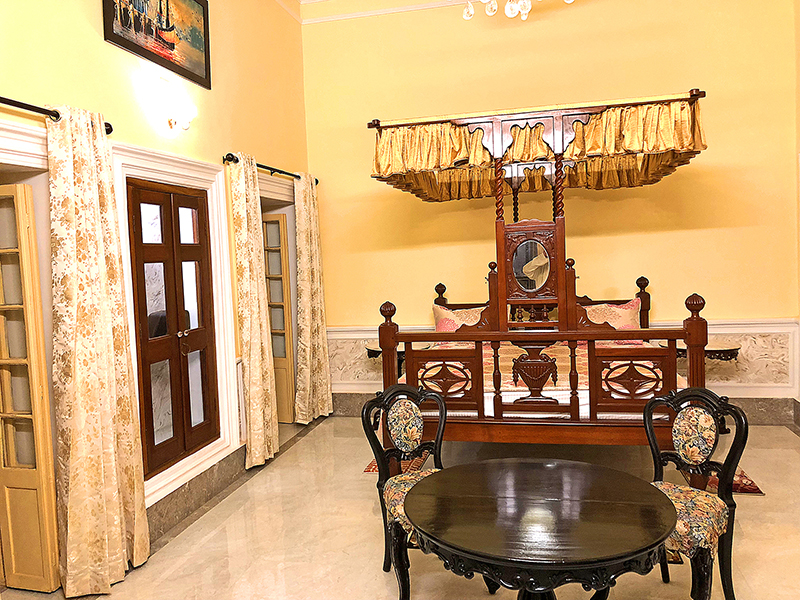
Deluxe room for guest – Cossimbazar Palace
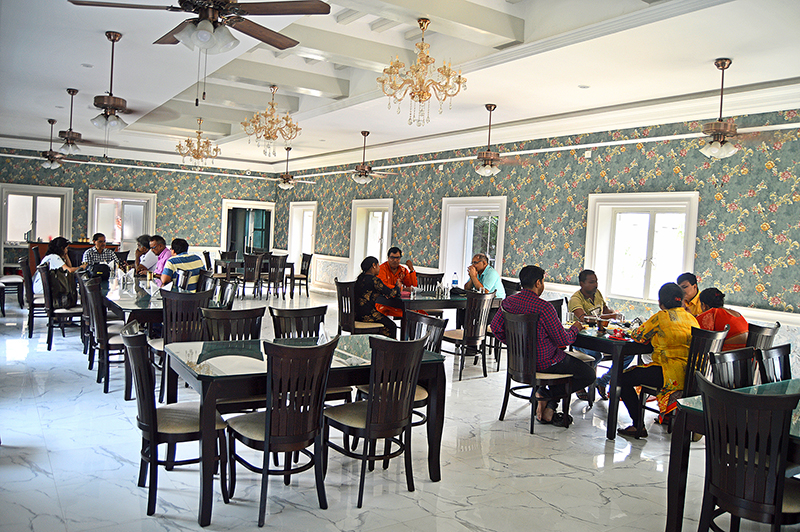
Cossimbazar Palace restaurant
The inside story
The construction of the palace began in the year 1735 on 35 bighas of land with two ponds (andarpukur) in a classic Indo-European style. As we entered the palace gate, we marvelled at its regal appearance, with the marble fountain on an octagonal patio and a bandstand in the front garden. The Clock Tower presenting a wonderful all-round view of the palace also serves as a major attraction.
On entering the central ball room, we were delighted by the decor, which was a throwback to the European influence with the elegant Victorian furniture, mirrors, chandeliers and imposing family portraits. The royal palanquin (palki) and the delicate artefacts on display speak volumes about the family’s glorious past. There is a majlishghar with arched and frescoed two-storeyed viewing galleries on either side which looks splendid after the revamp.
Rather intimidating is the huge five-arched hall (sabhaghar), a part of Chandimandap replete with beautiful floral motifs on the cornices, walls, frescoes and carvings. This hall which served as the court room is a perfect study of lofty Renaissance architecture.
The royal bedroom(shayan kaksha) looks gorgeous with its medieval touch – a traditional four-poster bed, clothes rack, an old-fashioned dressing-table and a tana pakha (a hand-pulled fan). The massive 20-feet dining table along with the beautifully carved cabinets, cupboards and other decorative pieces are the highlights of the dining room (khanakamra).
We then took a walk past the sprawling garden and the tennis court to enter the austere temple complex.During the festivals, pujas are held at the Chandimandap, which continues to attract people from nearby towns and villages round the year. We paid homage to the family deity of Radha Govinda Jiu in a temple decorated with arches and pillars, where the daily puja and arati are performed. There is also a complex of Das Shib Mandir (ten Shiva temples) – very close to the palace.
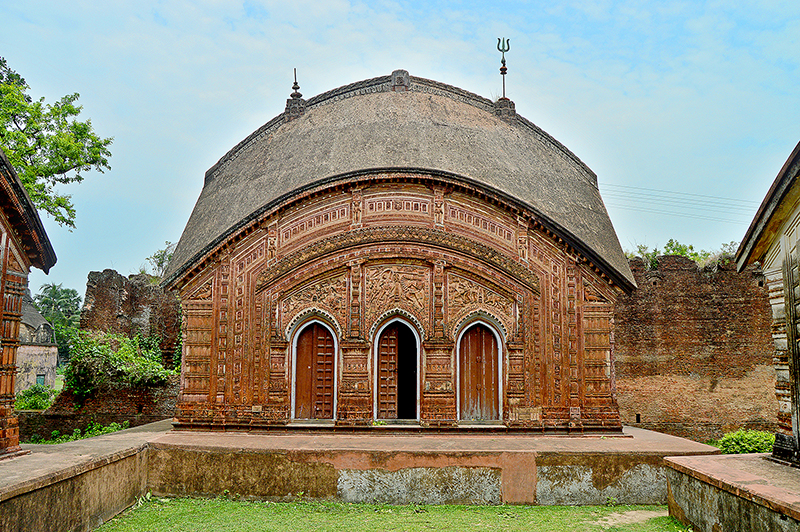
The Char Bangla Temples with immaculate terracotta work – Azimganj
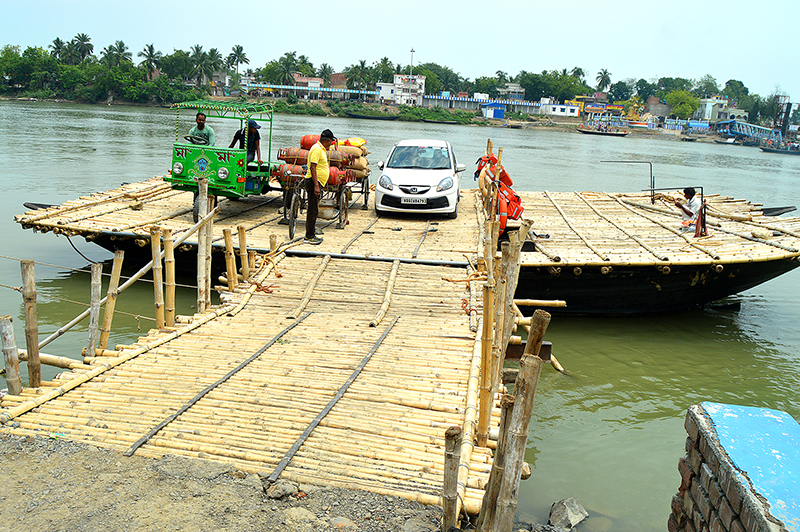
Crossing over to Azimganj availing the local ferry as a shortcut
AZIMGANJ
We set off for the day tour from Cossimbazar Palace early in the morning, after a light breakfast, and headed towards Jiaganj ferry ghat. Enroute we stopped at several historic spots such as the 17th century Dutch cemetery with tombs of 47 Dutch people who were primarily traders and businessmen.
Another spot of historic significance is the Katra Masjid, the mosque of Murshid Kuli Khan, one of the oldest examples of Islamic architecture built in 1723. Its vast open courtyard is surrounded by double storeyed cells and the mosque is said to have been an important centre for learning. So vast is the mosque that at least 2000 people can offer prayers here, at a time.
Finally, on arriving at the ferry ghat, we had an exciting experience of crossing the Ganges along with our car rolling down through an improvised bamboo jetty onto a ferry made of country boats, to cross over to Azimganj as a shortcut – the actual route being across the bridge on NH-12 (NH-34) over the river Ganges at Baharampur. Navigating the narrow, congested way out from the ferry ghat of Azimganj was quite a challenge. But the change in the landscape from uninteresting, nondescript village to an enchanting green surrounded with mango and jackfruit orchards quickly washed away every mark of stress. A good half an hour drive and we were at the spectacular terracotta Shiva temples, built by Rani Bhabani of Natore at Baranagar.
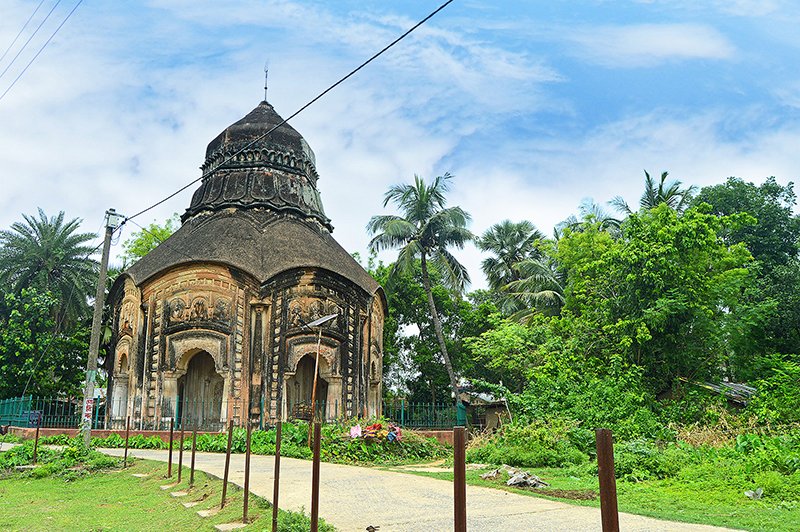
The unique Bhawaniswar Temple – Azimganj
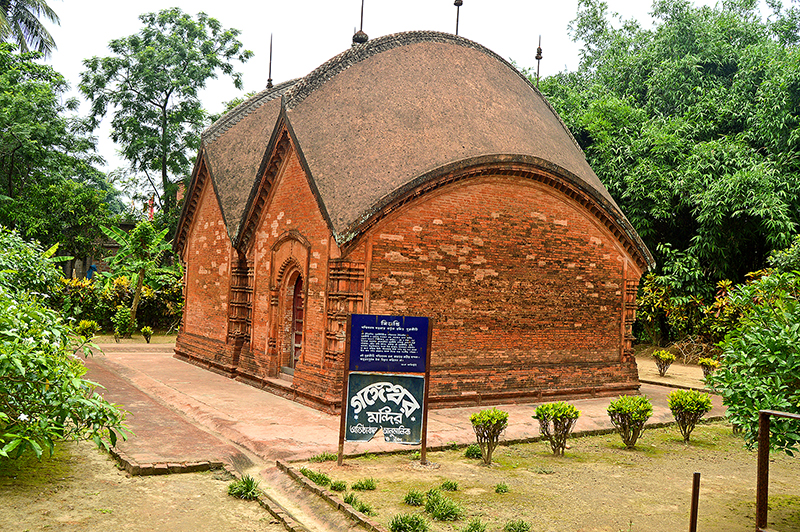
The enchanting Gangeswar temple – Azimganj
History
Rani Bhabani (1716-1795), the then zamindar of Rajshahi (now in Bangladesh), was famous for her sagacity, generosity and extensive social work. After the demise of her husband, Raja Ramakanta in 1748, she became the virtual zamindar of Rajshahi. She managed the vast zamindari efficiently and effectively for over four decades, maintaining cordial relations with the Nawabs of Bengal.
Rani Bhabani is said to have established about 380 shrines and guesthouses, built many temples in different parts of the country and endowed money and lands. She constructed a big road that ran from Natore to Bhawanipur in Bogra and is still called Rani Bhabanir Jangal. Besides, numerous water tanks and sarais were built with her money. She was a great patron of Hindu learning and bestowed large sums in the form of endowments for the spread of education.
Rani Bhabani Temples
We first visited the Char Bangla Temples at Baranagar village in Azimganj, high up on the banks of the Ganges. History has it that the pious and charitable Rani Bhabani who passed the later days of her life in this village, built the temples.
These magnificent terracotta temples were built in 1755. There are four temples enclosing a small courtyard, each having 3 arched openings and 3 richly decorated Shiva Lingas. The eastern temple is ornamented with delicate plaster work. The impeccably carved decorative themes are drawn mainly from the Hindu epics and puranas.
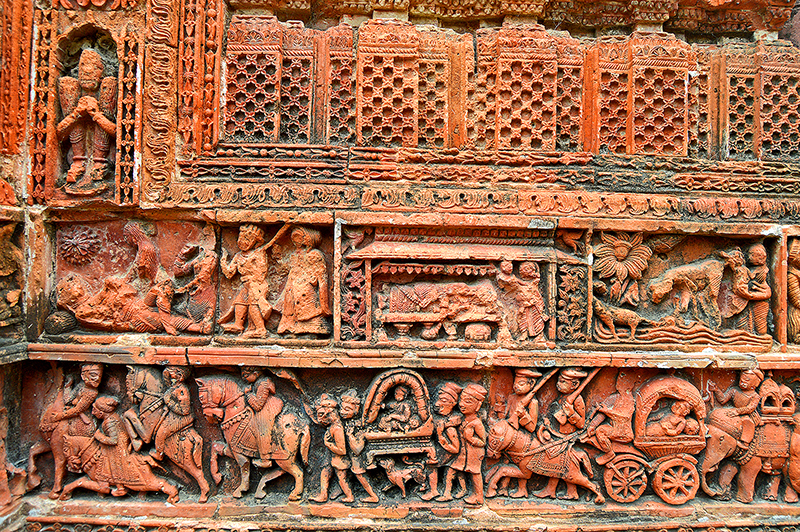
Intricate terracotta work at the Gangeswar Temple – Azimganj
Close to the Char Bangla Temples is the Bhavaniswar Temple. Dedicated to Shiva and remarkable for its height and unusual style, this temple has an octagonal structure with a domed interior and a corridor with sloping roof. In many places, it still retains the original ornamentation in plaster.
A little away is the Gangeswar Temple, amidst the fruit trees in a modest village setting. It is quite challenging to reach there by car, but the temple is another depiction of Bengal’s beautiful terracotta architecture. What left us in awe of these archetype constructions is the intricacy of the carvings depicting fables from the mythological legends, carvings which still remain unblemished and intact, untouched by the harshness of time.
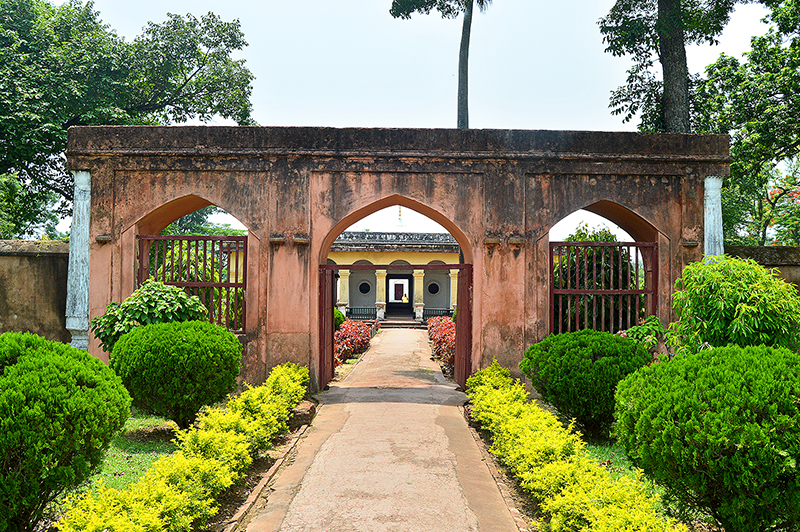
Khoshbagh, the final resting place of Siraj-ud-Dullah – Azimganj
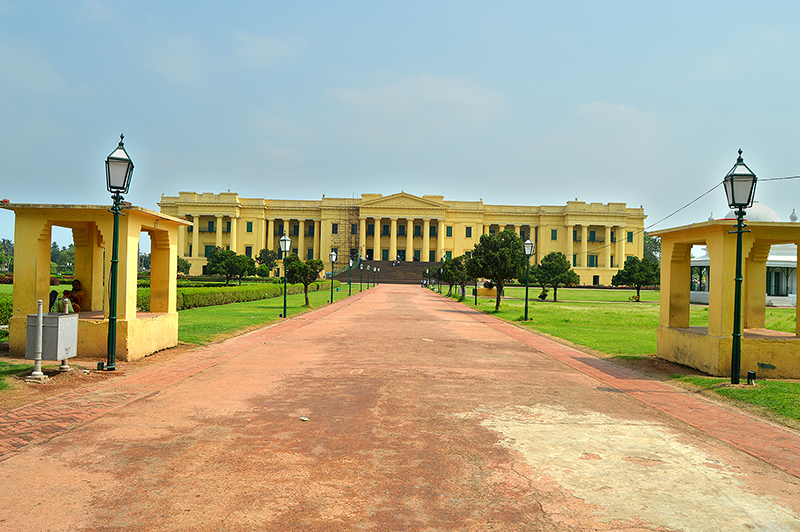
The spectacular Hazarduari Palace – Murshidabad
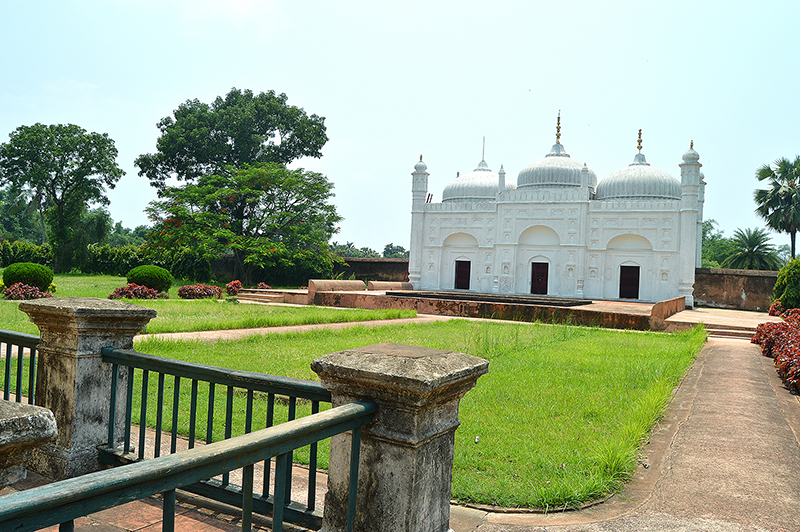
The Khoshbagh Mosque inside the Garden of Happiness
KHOSHBAGH
The ‘aura’ of the temples still fresh in our minds, we drove next to Khoshbagh in Azimganj along the Ganges.
Khoshbagh or the ‘Garden of Happiness’ was built by Nawab Aliverdi Khan (1740 – 1756) and houses the grave of Siraj-ud-Daulah and his second wife Lutf-un-nisa. It was built over 7.5 acres of land, along the lines of Jama Masjid of Delhi.
Soon after Siraj’s death in 1756, his wife Lutf-un-nisa refused to serve in the harem of Ali Zafar and fled to Dacca. Later she returned and lived for several years in Khoshbagh, tending to Siraj’s grave and the rose bushes. After her death in 1786, she was buried next to Siraj-ud-Daulah. At the far end of the garden is Khoshbagh Mosque, built in 1740.
Amidst the manicured lawns, are interred the remains of Nawab Aliverdi Khan, his mother, and his grandson Siraj-ud-Daulah inside a square flat-roofed chamber surrounded on all sides by an arcade verandah, Siraj’s wife Lutf-un-nisa and other members of the Nawab’s family. Also buried within the walled compound is Danish Fakir, who had betrayed Siraj’s hiding place to the British.
Accommodation
If you are keen to explore Cossimbazar Palace and Murshidabad over a royal stay, what can be a better boarding option than the Cossimbazar Palace per se?
It was in the early 90s that the Roys decided to have a go at the restoration of the palace. Many areas had been walled-up for lack of upkeep, heritage objects had been stolen and many of the sections had fallen into severe disrepair. “We have spent a fortune and almost 20 years now, to restore the palace – a daunting task, and today we are proud of the way the property has shaped up,” said Prosanta Kumar Roy, a scion of the Cossimbazar Roy family.
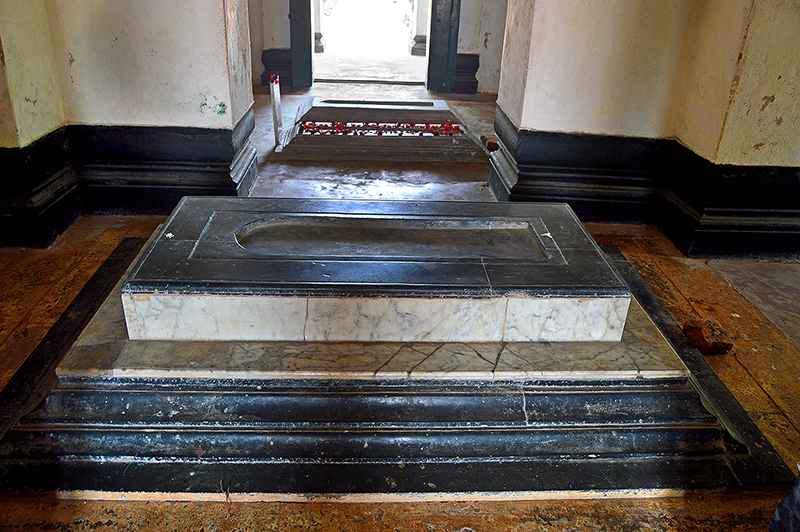
Siraj-ud-Daulahs tomb at Khoshbagh
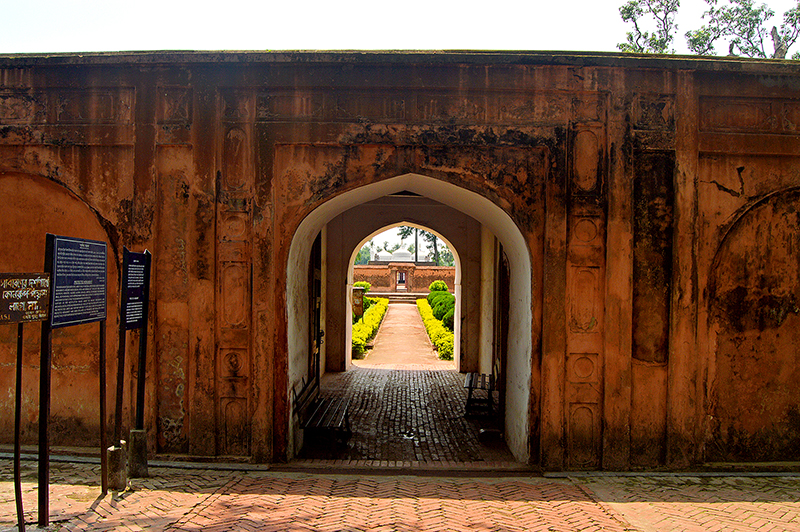
The entance to Khoshbagh
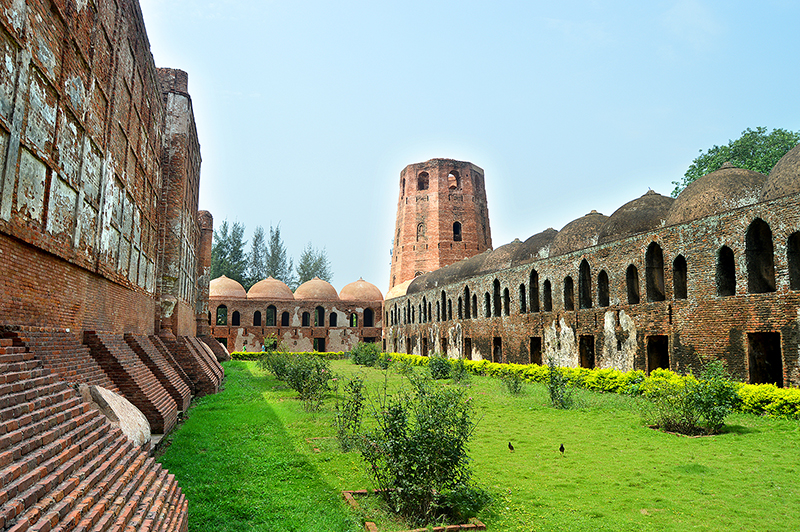
The magnificent Katra Masjid
The Roys have converted a few rooms of the palace into guest rooms where you can enjoy the old world charm and traditional hospitality. The classic decor of the rooms coupled with modern amenities is sure to leave you spellbound. The two rooms on the ground floor (a double and a quadruple occupancy suites) overlooking the lush green manicured garden will make your stay a delightful one.
On the first floor are three double bed rooms viz., the Pakkhiraj, Mayurpankhi and Airavat and two Royal suites viz., King and Queen, each one bearing a unique colour scheme and retaining the touch of royalty. Splendid is the terrace adjoining the verandah of the first floor and a perfect place for hosting private parties. Across the terrace is a suite meant for special guests, who crave privacy and are uncomfortable in a milieu. A huge dining table with chairs is set up in a room in front of a quaint little terrace on the first floor, which serves as the common room for a lazy evening adda for the guests staying at the palace.
Restaurant
The food is generally served at the sprawling Palace restaurant. The decor is striking with its teal-grey wallpapers adorned with beautiful floral motifs and white cornices. Our sumptuous, royal lunch was laid out in the restaurant in kansa (bell metal) utensils. It was a traditional Bengali spread, cooked to perfection. The restaurant has options for Chinese, Mughlai and pan-Indian cuisine as well. And for some quick bites you can grab the yummy savouries at The Sugarr and Spice Confectionery outlet inside the palace complex.
Other attractions
For the avid shopaholics, the retail outlet – Palatia Boutique adjoining the palace has an impressive stock of the famous Murshidabad silk sarees and other attractive apparel. Staying at the palace can be extremely rewarding especially if you avail the Royal Bus for sight-seeing or to reach the palace from Kolkata.
Sinking back into the plump silk-satin tasselled cushioned seats, one is transported back to a bygone era of elegant luxury. It is a journey one wishes would not easily end.
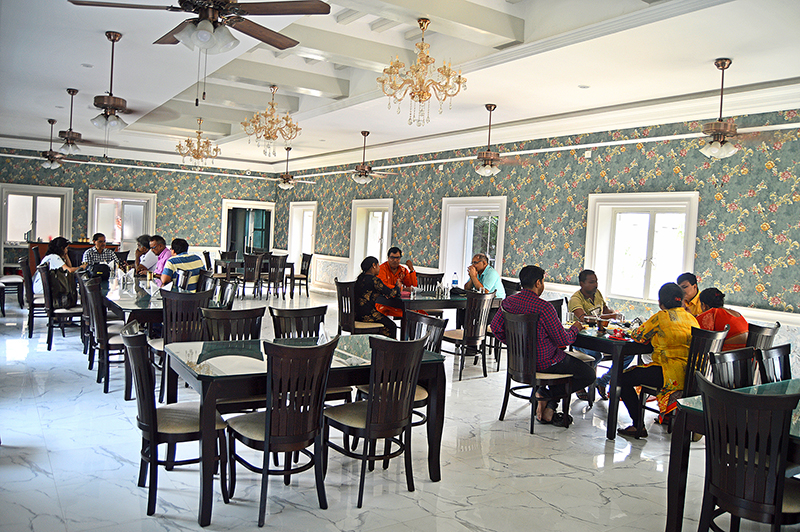
Standard : A